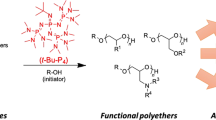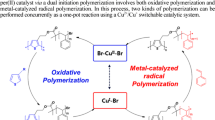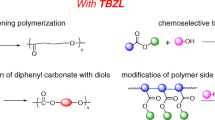Abstract
Alcohol end-functionalized poly(3-hexylthiophene) (P3HT-OH) is a high-value material used for the generation of conjugated P3HT-coil block copolymers via controlled polymerization methods. Previously, P3HT-OH was prepared by Kumada catalyst-transfer polycondensation, which required effort-intensive postpolymerization modifications and additional protecting group techniques. Herein, we report the direct one-pot synthesis of P3HT-OH by Suzuki-Miyaura catalyst-transfer polycondensation. Mild reaction conditions with good functional group tolerance allowed the preparation of well-defined P3HT-OH without protective groups or postmodification processes. Notably, the [Pd]/[alcohol initiator] ratio should be ≤1 to obtain well-defined P3HT-OH because at this ratio the oxidation of the alcohol group is suppressed, which reduces end-group fidelity. Moreover, the polymerization should be quenched before full conversion of the monomer to prevent disproportionation into P3HT dimers. The high end-group fidelity of P3HT-OH was confirmed by block copolymerization with polystyrene through atom-transfer radical polymerization. Our protocol provides facile access to P3HT-OH, which is useful for small-molecule functionalization and block copolymer synthesis.





Similar content being viewed by others
References
Yang CD, Lee JK, Heeger AJ, Wudl F. Well-defined donor–acceptor rod–coil diblock copolymers based on P3HT containing C60: the morphology and role as a surfactant in bulk-heterojunction solar cells. J Mater Chem. 2009;19:5416–23.
Segalman RA, McCulloch B, Kirmayer S, Urban JJ. Block copolymers for organic optoelectronics. Macromolecules. 2009;42:9205–16.
Malliaras GG, Herrema JK, Wildeman J, Wieringa RH, Gill RE, Lampoura SS, et al. Tuning of the photo‐ and electroluminescence in multi‐block copolymers of poly[(silanylene)thiophene]s via exciton confinement. Adv Mater 1993;5:721–23.
Boudouris BW, Frisbie CD, Hillmyer MA. Nanoporous poly(3-alkylthiophene) thin films generated from block copolymer templates. Macromolecules. 2008;41:67–75.
Li Z, Ono RJ, Wu Z-Q, Bielawski CW. Synthesis and self-assembly of poly(3-hexylthiophene)-block-poly(acrylic acid). Chem Commun 2011;47:197–9.
Boufflet P, Casey A, Xia Y, Stavrinou PN, Heeney M. Pentafluorobenzene end-group as a versatile handle for para fluoro “click” functionalization of polythiophenes. Chem Sci 2017;8:2215–25.
Kim J-S, Kim Y, Kim H-J, Kim HJ, Yang H, Jung YS, et al. Regioregularity-driven morphological transition of poly(3-hexylthiophene)-based block copolymers. Macromolecules. 2017;50:1902–8.
Nguyen TH, Nguyen LT, Nguyen VQ, Pan LNT, Zhang G, Yokozawa T, et al. Synthesis of poly(3-hexylthiophene) based rod–coil conjugated block copolymers via photoinduced metal-free atom transfer radical polymerization. Polym Chem 2018;9:2484–93.
Ho V, Boudouris BW, McCulloch BL, Shuttle CG, Burkhardt M, Chabinyc ML, et al. Poly(3-alkylthiophene) diblock copolymers with ordered microstructures and continuous semiconducting pathways. J Am Chem Soc 2011;133:9270–3.
Iovu MC, Craley R, Jeffries M, Krankowski AB, Zhang R, Kowalewski T, et al. Conducting regioregular polythiophene block copolymer nanofibrils synthesized by reversible addition fragmentation chain transfer polymerization (RAFT) and nitroxide mediated polymerization (NMP). Macromolecules 2007;40:4733–5.
Lee JU, Jung JW, Emrick T, Russell TP, Jo WH. Synthesis of C60-end capped P3HT and its application for high performance of P3HT/PCBM bulk heterojunction solar cells. J Mater Chem 2010;20:3287–94.
Handa NV, Serrano AV, Robb MJ, Hawker CJ. Exploring the synthesis and impact of end-functional poly(3-hexylthiophene). J Polym Sci Part A: Polym Chem 2015;53:831–841.
Ouchi M, Terashima T, Sawamoto M. Transition metal-catalyzed living radical polymerization: toward perfection in catalysis and precision polymer synthesis. Chem Rev 2009;109:4963–5050.
Matyjaszewski K, Xia J. Atom transfer radical polymerization. Chem Rev 2001;101:2921–90.
Chiefari J, Chong YK, Ercole F, Krstina J, Jeffery J, Le TPT, et al. Living free-radical polymerization by reversible addition-fragmentation chain transfer: the RAFT process. Macromolecules. 1998;31:5559–62.
Aoshima S, Kanaoka S. A renaissance in living cationic polymerization. Chem Rev 2009;109:5245–87.
Yokozawa T, Ohta Y. Transformation of step-growth polymerization into living chain-growth polymerization. Chem Rev 2016;116:1950–68.
Yokoyama A, Miyakoshi R, Yokozawa T. Chain-growth polymerization for poly(3-hexylthiophene) with a defined molecular weight and a low polydispersity. Macromolecules. 2004;37:1169–71.
Smeets A, Bergh KV, Winter JD, Gerbaux P, Verbiest T, Koeckelberghs G. Incorporation of different end groups in conjugated polymers using functional nickel initiators. Macromolecules. 2009;20:7638–41.
Higashihara T, Goto E, Ueda M. Purification-free and protection-free synthesis of regioregular poly(3-hexylthiophene) and poly(3-(6-hydroxyhexyl)thiophene) using a zincate complex of tBu4ZnLi2. ACS Macro Lett. 2012;1:167–70.
Inagaki S, Yamamoto T, Higashihara T. Direct synthesis of chain‐end‐functionalized poly(3‐hexylthiophene) without protecting groups using a zincate complex. Macromol Rapid Commun. 2020;41:200148.
Miyaura N, Suzuki A. A new stereospecific cross-coupling by the palladium-catalyzed reaction of 1-alkenylboranes with 1-alkenyl or 1-alkynyl halides. Tetrahedron Lett. 1979;20:3437–40.
Seo K-B, Lee I-H, Lee J, Choi I, Choi T-L. A rational design of highly controlled Suzuki−Miyaura catalysttransfer polycondensation for precision synthesis of polythiophenes and their block copolymers: marriage of palladacycle precatalysts with MIDA-boronates. J Am Chem Soc 2018;140:4335–43.
Kobayashi S, Fujiwara K, Jiang D-H, Yamamoto T, Tajima K, Yamamoto Y, et al. Suzuki–Miyaura catalyst-transfer polycondensation of triolborate-type fluorene monomer: toward rapid access to polyfluorenecontaining block and graft copolymers from various macroinitiators. Polym Chem 2020;11:6832–39.
Choi H-N, Yang H-S, Chae J-H, Choi T-L, Lee I-H. Synthesis of conjugated rod-coil block copolymers by RuPhos Pd-catalyzed Suzuki-Miyaura catalyst-transfer polycondensation: initiation from coil-type polymers. Macromolecules. 2020;53:5497–503.
Lee JH, Park H, Hwang S-H, Lee I-H, Choi T-L. RuPhos Pd precatalyst and MIDA boronate as an effective combination for the precision synthesis of poly(3-hexylthiophene): systematic investigation of the effects of boronates, halides, and ligands. Macromolecules. 2020;53:3306–14.
Rudenko AE, Thompson BC. Optimization of direct arylation polymerization (DArP) through the identification and control of defects in polymer structure. J Polym Sci Part A: Polym Chem 2015;53:135–47.
Bautista MV, Varni AJ, Ayuso-Carrillo J, Tsai C-H, Noonan KJT. Chain-growth polymerization of benzotriazole using Suzuki–Miyaura cross-coupling and dialkylbiarylphosphine palladium catalysts. ACS Macro Lett. 2020;9:1357–62.
Jiang D-H, Ree BJ, Isono T, Xia X-C, Hsu L-C, Kobayashi S, et al. Facile one-pot synthesis of rod-coil bio-block copolymers and uncovering their role in forming the efficient stretchable touch-responsive light emitting diodes. Chem Eng J. 2021;418:129421–9.
Javier AE, Patel SN, Hallinan DT, Srinivasan V, Balsara NP. Simultaneous electronic and ionic conduction in a block copolymer: application in lithium battery electrodes. Angew Chem Int Ed 2011;50:9848–51.
Hu J, Zhang G, Geng Y, Liu S. Micellar nanoparticles of coil–rod–coil triblock copolymers for highly sensitive and ratiometric fluorescent detection of fluoride ions. Macromolecules. 2011;44:8207–14.
de Cuendias A, Hiorns RC, Cloutet E, Vignau L, Cramail H. Conjugated rod–coil block copolymers and optoelectronic applications. Polym Int 2010;59:1452–76.
Lee YJ, Kim SH, Yang H, Jang M, Hwang SS, Lee HS, et al. Vertical conducting nanodomains self-assembled from poly(3-hexyl thiophene)-based diblock copolymer thin films. J Phys Chem C 2011;115:4428–34.
Sary N, Richard F, Brochon C, Leclerc N, Lévêque P, Audinot J-N, et al. A new supramolecular route for using rod‐coil block copolymers in photovoltaic applications. Adv Mater 2010;22:763–68.
Wang J-T, Takshima S, Wu H-C, Shin CC, Isono T, Kakuchi T, et al. Stretchable conjugated rod–coil poly(3-hexylthiophene)-block-poly(butyl acrylate) thin films for field effect transistor applications. Macromolecules. 2017;50:1442–52.
Olsen BD, Segalman RA. Self-assembly of rod-coil block copolymers. Mater Sci Eng R 2008;62:37–66.
Li J-H, Li Y, Xu J-T, Luscombe CK. Self-assembled amphiphilic block copolymers/CdTe nanocrystals for efficient aqueous-processed hybrid solar cells. ACS Appl Mater Interfaces 2017;9:17942–48.
Acknowledgements
The authors are thankful for financial support from the Beginning Independent Researcher Program (No. 2018R1C1B5083261), Young Researcher Program (No. 2021R1C1C1006090), Carbon to X Project (No. 2020M3H7A1098281), and the Center for Convergence Research of Neurological Disorders (No. 2019R1A5A2026045) through the National Research Foundation of Korea.
Author information
Authors and Affiliations
Corresponding author
Ethics declarations
Conflict of interest
The authors declare no competing interests.
Additional information
Publisher’s note Springer Nature remains neutral with regard to jurisdictional claims in published maps and institutional affiliations.
Supplementary information
Rights and permissions
About this article
Cite this article
Choi, HN., Lee, IH. Protection-free one-pot synthesis of alcohol end-functionalized poly(3-hexylthiophene). Polym J 53, 1205–1211 (2021). https://doi.org/10.1038/s41428-021-00522-x
Received:
Revised:
Accepted:
Published:
Issue Date:
DOI: https://doi.org/10.1038/s41428-021-00522-x
- Springer Nature Limited




